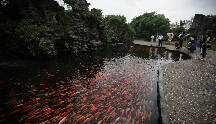Back in Time: Visit to a Dong Village
The Dong people’s houses are built of fir. From afar, these houses look like an ascending cluster of mushrooms. On first appraisal, the drum tower stands out as the most distinctive architecture worth visiting, one of the hallmarks of a Dong village. The outward appearance of the tower is a polygonal pagoda, generally around 20 meters high and sporting anywhere from three to 15 floors. To signal important meetings, the head of the village will send someone up to beat the huge drum hanging at its uppermost point. Upon hearing the drum, the villagers immediately congregate in front of the tower.
Besides serving as a meeting venue, the drum tower grounds are also an ideal place for villagers to spend their leisure time. Hot summers find them gathering at the tower to cool off; on cold winter days, fire pits draw people round to sit and listen to the elderly telling stories. On festivals or visits from important guests, people gather here for lusheng playing, singing and dancing. So the drum tower is a must for tourists, who can witness cultural activities unfold here and understand more about local folk customs. What should be noted is that visitors must get the approval of local residents if they want to enter or climb up the drum tower.
Back to the wind-and-rain bridge, another signature piece of architecture in Dong villages. This also serves as a place where people meet to sing, dance or indulge in other recreational pursuits, sheltered from rain or sun. At 246.7 meters in length and 12.2 meters across, the Longjin Wind-and-Rain Bridge we visited in Zhijiang County in Hunan Province is the largest of its kind in the world. A complex of corridors and pavilions, it sports seven pagoda-like, multi-tier pavilions with flying eaves. The pillars and beams are decorated with two dragons playing with a ball and a couple of phoenix contented with each other’s company. In the corridor we saw some older Dong ladies casually executing beautiful embroidery work. Behind them was a small temple housing the village’s first line of spiritual defence – the bridge god.
In addition to an impressive exterior, Dong architecture also features highly skilled craftsmanship. Both towers and bridges are made with sturdy mortise and tenon joints, so that not a single rivet or nail is used. The resulting structures endure for hundreds of years.
According to a local Dong architect named Huang Weiyu, no matter how sophisticated Dong architecture looks, no blueprint is needed. Preparing the materials for construction, Dong architects and builders make marks only they can understand on a split bamboo pole used as the sole measuring tool.
Big Songs for a Big Soul
The Dong “Big Song” is well-known both at home and abroad for its amazing musical concord polyphonic style, which seems to carry the audience aloft into natural wonderlands. It is said that as the Dong choral tradition developed it folded in daily life and natural surroundings: the chorus of a song may be modeled on flickering cicada wings, bird calls or the burbling of running streams. Gradually the famous Dong Big Song, a multi-part cappella, was formed, with a chorus both deep and bright. Dong Big Song made a big splash at its Paris debut in 1986. Nowadays many visitors come to Dong villages especially for appreciating the Dong Big Song in its proper context. Strolling in a Dong village, you are moving in a melodic soundscape. It seems every villager is a good singer, and to them singing enjoys the same respect as eating. The Dong people have a saying, “Foods feed the body, while songs feed the soul.”
Dong embroidery is also superb. The headbands and cloth shoes worn by Dong girls are all embroidered with intricate patterns, such as their ethnic totem, dragons and phoenix, or Chinese firs. Locals told me that the ceremonial garments worn by the Dong are made with about six to seven separate embroidery stitches and normally it takes anywhere from several months to a few years to make one dress. The techniques are so complicated that it is impossible to imitate these patterns with modern machines. While there I happened to see Dong girls dyeing cloth with indigo and displaying elaborately embroidered clothes on the walls. Placing their exquisite handicrafts in view is as far as the Dong will go to attract tourists and buyers. The price they set is also very modest. If my experience is of any interest, I spent RMB 15 for a handicraft item, and like the rest of the trip, it was more than worth it.
Services
Economy
- Eco-agriculture and Eco-tourism Power Nanchang’s Green Development
- Balance Environmental Protection and Economic Prosperity – Nanchang Looks to European Technology for Green Development
- Sustainable Growth Requires Wiser Energy Use
- Chinese Economy: On the Path of Scientific Development
- China's Economy over the Last Ten Years

